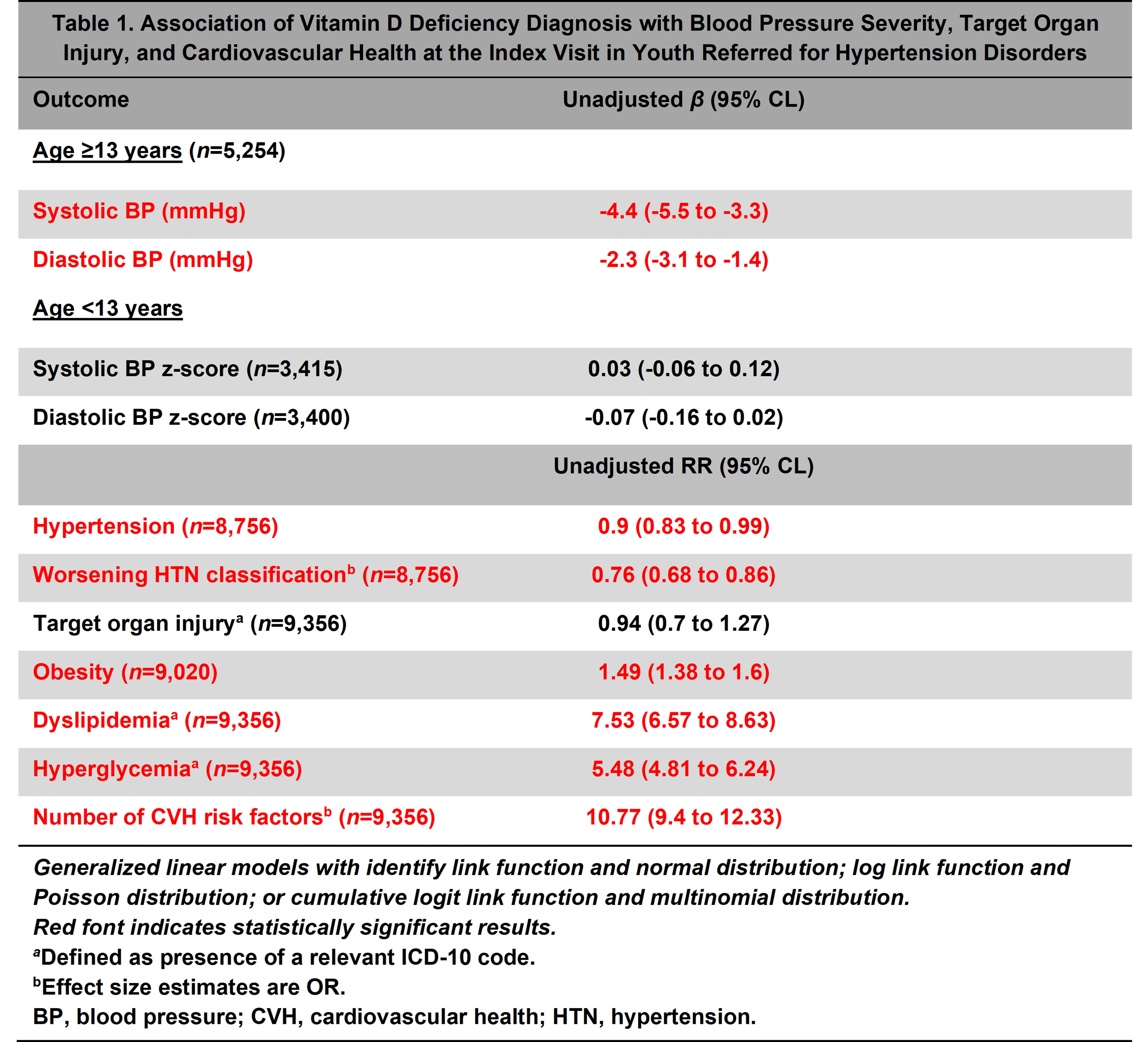Hypertension
Session: Hypertension
038 - Association of Vitamin D deficiency with Blood Pressure Severity and Cardiovascular Health at Baseline in Youth Referred for Hypertension, A SUPERHERO Analysis
Saturday, April 26, 2025
2:30pm - 4:45pm HST
Publication Number: 38.3834
Rushelle Byfield, NewYork-Presbyterian Morgan Stanley Children's Hospital, New York, NY, United States; Landon T. Sanz, Wake Forest School of Medicine of Wake Forest Baptist Medical Center, Spring, TX, United States; Margaret Murphy, University of Kentucky College of Medicine, Lexington, KY, United States; Andrew M. South, Wake Forest School of Medicine of Wake Forest Baptist Medical Center, Winston Salem, NC, United States

Rushelle Byfield, MD (she/her/hers)
Assistant Professor
Columbia University Irving Medical Center
New York, New York, United States
Presenting Author(s)
Background: Vitamin D deficiency is widespread among youth in the US and there are mechanisms to link vitamin D deficiency to cardiometabolic and cardiovascular (CV) risk. However, few large-scale studies have examined the association of vitamin D deficiency and hypertension (HTN) disorders in youth
Objective: Estimate the association of vitamin D deficiency with blood pressure (BP) severity and cardiovascular health at baseline in youth referred for HTN disorders.
Design/Methods: Cross sectional analysis of baseline data from the Study of the Epidemiology of Pediatric Hypertension (SUPERHERO), a retrospective Registry of electronic health record data. Data were acquired using standardized biomedical informatics scripts and validated by randomly selected manual record review. Inclusion criteria were youth < 19 years old who received care from subspecialists for HTN disorders from 1/1/2016–12/31/2023 defined by ICD-10 codes. Exclusion criteria were kidney failure on dialysis, kidney transplantation, or pregnancy by ICD-10 codes. Exposure was vitamin D deficiency defined by ICD-10 code (E55.9). Outcomes were markers for CV health including BP severity per national guidelines, obesity as body mass index or weight-for-length ≥95th %ile, dyslipidemia, and hyperglycemia and target organ injury to heart or kidney by ICD-10 codes. Unadjusted generalized linear models were used.
Results: Of the 9,356 participants in this analysis, 38% were female, the median age was 14 years (IQR 10.5-16.3). 11% had vitamin D deficiency. Youth with an ICD-10-coded visit diagnosis for Vitamin D deficiency had higher risk of obesity (RR 1.49, 95%CL 1.38-1.6), dyslipidemia (RR 7.53, 95%CL 6.5-8.63), hyperglycemia (RR 5.48, 95%CL 4.18-6.24) and higher odds of having multiple cardiovascular health risk factors (OR 10.77, 95% CI 9.4-12.33). However, vitamin D deficiency was associated with lower risk for HTN (RR 0.9 95% CI 0.83-0.99) and lower odds of worsening BP classification (OR 0.76 95%CI 0.68 - 0.86).
Conclusion(s): In this analysis from a large multicenter registry of youth with HTN disorders, vitamin D deficiency diagnosis was associated with higher risk of obesity, dyslipidemia and hyperglycemia as well as higher odds of multiple CV health risk factors. Despite the strong association with adverse metabolic risk factors, vitamin D deficiency was associated with lower risk of hypertension, suggesting there are additional pathophysiological mechanisms at play. Future studies are needed to establish if vitamin D supplementation can effectively mitigate cardiometabolic risk in youth
Table 1. Association of Vitamin D Deficiency Diagnosis with Blood Pressure Severity, Target Organ Injury, and Cardiovascular Health at the Index Visit in Youth Referred for Hypertension Disorders


